Polymerization-Driven Immobilization of dc-APGD Synthesized Gold Nanoparticles into a Quaternary Ammonium-Based Hydrogel Resulting in a Polymeric Nanocomposite with Heat-Transfer Applications
Abstract
:1. Introduction
2. Materials and Methods
2.1. Reagents and Solutions
2.2. Polymerization-Driven Immobilization of Raw Gold Nanoparticles (AuNPs) in Quaternary Ammonium-Based Hydrogel
- (i).
- NC1: Free-radical polymerization was carried out at 75 °C for 24 h. The resultant product was extensively washed with re-distilled water on a frittered glass funnel until the pH of the outflow was neutral. It was then dried and used for further procedures.
- (ii).
- NC2: The process was performed as was described in the procedure (i) with the difference that the polymerization was run until the gelation point (up to 30 min). Next, the reaction mixture was quickly cooled down and the resultant product was washed with re-distilled water in order to remove excessive AuNPs precursor.
- (iii).
- NC3: The process was carried out as in the procedure (i) with the difference that the reaction mixture was prepared with the addition of NaOH at a 2:1 molar ratio with respect to VBTAC.
2.3. Characterization of the Obtained Polymeric Nanocomposites
2.4. Assessing the Potential of the Nanocomposite for Heat Transfer
3. Results and Discussion
3.1. Application of Direct Current Atmospheric Pressure Glow Discharge (dc-APGD) for the Synthesis of Raw-AuNPs
3.2. Fourier Transform Infrared Spectroscopy (FT-IR) Analysis of Obtained Materials
3.3. Transmission Electron Microscopy (TEM) Photomicrographs of the Obtained Materials
3.4. Mechanism of Synthesis of Polymeric Nanocomposite
3.5. Evaluation of the Heat-Transfer Rate
4. Conclusions
5. Patents
Acknowledgments
Author Contributions
Conflicts of Interest
Abbreviations
| APP | atmospheric pressure plasma |
| AuNPs | gold nanoparticles |
| Au/VBTAC-co-MBA | nanocomposite containing gold nanparticles immobilized within (vinylbenzyl)trimethylammonium chloride-co-N,N-methylenebisacrylamide copolymer |
| dc-APGD | direct current atmospheric pressure glow discharge |
| DLS | dynamic light scattering |
| EDS | energy-dispersive X-ray spectroscopy |
| FLA | flowing liquid anode |
| FT-IR | Fourier transformation infrared spectroscopy |
| ID | internal diameter |
| LSPR | localized surface plasmon resonance |
| MBA | N,N-methylenebisacrylamide |
| NFs | nanofluids |
| NMs | nanomaterials |
| NPs | nanoparticles |
| OD | outside diameter |
| RONS | reactive oxygen and nitrogen species |
| TEM | transmission electron microscopy |
| UV–Vis | ultraviolet-visible |
| VBTAC | (vinylbenzyl)trimethylammonium chloride |
References
- Berger, M. Nano-Society. Pushing the Boundaries of Technology; Rsc Nanoscience & Nanotechnology; RCS Publishing: Cambridge, UK, 2009. [Google Scholar]
- Ramsden, J.J. Nanotechnology: An Introduction; Elsevier: New York, NY, USA, 2011. [Google Scholar]
- Baglioni, P.; Carretti, E.; Chelazzi, D. Nanomaterials in Art Conservation. Nat. Nanotechnol. 2015, 10, 287–290. [Google Scholar] [CrossRef] [PubMed]
- Pitkethly, M.J. Nanomaterials—The Driving Force. Mater. Today 2004, 7 (Suppl. 12), 20–29. [Google Scholar] [CrossRef]
- Hasan, S. A Review on Nanoparticles: Their Synthesis and Types. Res. J. Recent Sci. 2015, 4, 9–11. [Google Scholar]
- Thompson, D.T. Using Gold Nanoparticles for Catalysis. Nano Today 2007, 2, 40–43. [Google Scholar] [CrossRef]
- Sarkar, S.; Guibal, E.; Quignard, F.; SenGupta, A.K. Polymer-Supported Metals and Metal Oxide Nanoparticles: Synthesis, Characterization, and Applications. J. Nanopart. Res. 2012, 14, 715. [Google Scholar] [CrossRef]
- Richmonds, C.; Mohan Sankaran, R. Plasma-Liquid Electrochemistry: Rapid Synthesis of Colloidal Metal Nanoparticles by Microplasma Reduction of Aqueous Cations. Appl. Phys. Lett. 2008, 93, 131501. [Google Scholar] [CrossRef]
- Patel, J.; Němcová, L.; Maguire, P.; Graham, W.G.; Mariotti, D. Synthesis of Surfactant-Free Electrostatically Stabilized Gold Nanoparticles by Plasma-Induced Liquid Chemistry. Nanotechnology 2013, 24, 245604. [Google Scholar] [CrossRef] [PubMed]
- Fumiyoshi, T.; Yudai, S.; Naoki, S.; Satoshi, U. Chemical reactions in liquid induced by atmospheric-pressure dc glow discharge in contact with liquid. Jpn. J. Appl. Phys. 2014, 53, 126201. [Google Scholar] [CrossRef]
- Naoki, S.; Satoshi, U.; Fumiyoshi, T. Synthesis of metal nanoparticles by dual plasma electrolysis using atmospheric dc Glow discharge in contact with liquid. Jpn. J. Appl. Phys. 2014, 53, 046202. [Google Scholar] [CrossRef]
- Chiang, W.-H.; Carolyn, R.; Mohan Sankaran, R. Continuous-Flow, Atmospheric-Pressure Microplasmas: A Versatile Source for Metal Nanoparticle Synthesis in the Gas or Liquid Phase. Plasma Sources Sci. Technol. 2010, 19, 034011. [Google Scholar] [CrossRef]
- De Vos, C.; Baneton, J.; Witzke, M.; Dille, J.; Godet, S.; Gordon, M.J.; Mohan Sankaran, R.; Reniers, F. A Comparative Study of the Reduction of Silver and Gold Salts in Water by a Cathodic Microplasma Electrode. J. Phys. D Appl. Phys. 2017, 50, 105206. [Google Scholar] [CrossRef]
- Mariotti, D.; Patel, J.; Švrček, V.; Maguire, P. Plasma-Liquid Interactions at Atmospheric Pressure for Nanomaterials Synthesis and Surface Engineering. Plasma Process. Polym. 2012, 9, 1074–8105. [Google Scholar] [CrossRef]
- Dzimitrowicz, A.; Jamroz, P.; Nyk, M.; Pohl, P. Application of Direct Current Atmospheric Pressure Glow Microdischarge Generated in Contact with a Flowing Liquid Solution for Synthesis of Au-Ag Core-Shell Nanoparticles. Materials 2016, 9, 268. [Google Scholar] [CrossRef] [PubMed]
- Dzimitrowicz, A.; Lesniewicz, T.; Greda, K.; Jamroz, P.; Nyk, M.; Pohl, P. Production of Gold Nanoparticles Using Atmospheric Pressure Glow Microdischarge Generated in Contact with a Flowing Liquid Cathode—A Design of Experiments Study. RSC Adv. 2015, 5, 90534–90541. [Google Scholar] [CrossRef]
- Dzimitrowicz, A.; Greda, K.; Lesniewicz, T.; Jamroz, P.; Nyk, M.; Pohl, P. Size-Controlled Synthesis of Gold Nanoparticles by a Novel Atmospheric Pressure Glow Discharge System with a Metallic Pin Electrode and a Flowing Liquid Electrode. RSC Adv. 2016, 6, 80773–80783. [Google Scholar] [CrossRef]
- Das, S.K.; Choi, S.U.S.; Patel, H.E. Heat Transfer in Nanofluids—A Review. Heat Transf. Eng. 2006, 27, 3–19. [Google Scholar] [CrossRef]
- Li, T.X.; Lee, J.-H.; Wang, R.Z.; Kang, Y.T. Enhancement of Heat Transfer for Thermal Energy Storage Application Using Stearic Acid Nanocomposite with Multi-Walled Carbon Nanotubes. Energy 2013, 55, 752–761. [Google Scholar] [CrossRef]
- Xuan, Y.; Li, Q. Heat Transfer Enhancement of Nanofluids. Int. J. Heat Fluid Flow 2000, 21, 58–64. [Google Scholar] [CrossRef]
- Kakaç, S.; Pramuanjaroenkij, A. Review of Convective Heat Transfer Enhancement with Nanofluids. Int. J. Heat Mass Transf. 2009, 52, 3187–3196. [Google Scholar] [CrossRef]
- Patel, H.E.; Das, S.K.; Sundararajan, T.; Nair, A.S.; George, B.; Pradeep, T. Thermal Conductivities of Naked and Monolayer Protected Metal Nanoparticle Based Nanofluids: Manifestation of Anomalous Enhancement and Chemical Effects. Appl. Phys. Lett. 2003, 83, 2931–2933. [Google Scholar] [CrossRef]
- Tsai, C.Y.; Chien, H.T.; Ding, P.P.; Chan, B.; Luh, T.Y.; Chen, P.H. Effect of Structural Character of Gold Nanoparticles in Nanofluid on Heat Pipe Thermal Performance. Mater. Lett. 2004, 58, 1461–1465. [Google Scholar] [CrossRef]
- Lee, J.; Tan, C.Y.; Lee, S.-K.; Kim, Y.-H.; Lee, K.Y. Controlled Delivery of Heat Shock Protein Using an Injectable Microsphere/Hydrogel Combination System for the Treatment of Myocardial Infarction. J. Control. Release 2009, 137, 196–202. [Google Scholar] [CrossRef] [PubMed]
- Zhang, R.-C.; Sun, D.; Zhang, R.; Lin, W.-F.; Macias-Montero, M.; Patel, J.; Askari, S.; McDonald, C.; Mariotti, D.; Maguire, P. Gold Nanoparticle-Polymer Nanocomposites Synthesized by Room Temperature Atmospheric Pressure Plasma and Their Potential for Fuel Cell Electrocatalytic Application. Sci. Rep. 2017, 7, 46682. [Google Scholar] [CrossRef] [PubMed]
- Li, S.; Lin, M.M.; Toprak, M.S.; Kim, D.K.; Muhammed, M. Nanocomposites of Polymer and Inorganic Nanoparticles for Optical and Magnetic Applications. Nano Rev. 2010, 1. [Google Scholar] [CrossRef] [PubMed]
- Li, J.; Ma, J.; Jiang, T.; Wang, Y.; Wen, X.; Li, G. Constructing Biopolymer-Inorganic Nanocomposite through a Biomimetic Mineralization Process for Enzyme Immobilization. Materials 2015, 8, 6004–6017. [Google Scholar] [CrossRef] [PubMed]
- Praharaj, S.; Nath, S.; Ghosh, K.; Kundu, S.; Pal, T. Immobilization and Recovery of Au Nanoparticles from Anion Exchange Resin: Resin-Bound Nanoparticle Matrix as a Catalyst for the Reduction of 4-Nitrophenol. Langmuir 2004, 20, 9889–9892. [Google Scholar] [CrossRef] [PubMed]
- Cyganowski, P.; Garbera, K.; Leśniewicz, A.; Wolska, J.; Pohl, P.; Jermakowicz-Bartkowiak, D. The Recovery of Gold from the Aqua Regia Leachate of Electronic Parts Using a Core-Shell Type Anion Exchange Resin. J. Saudi Chem. Soc. 2017, 21, 741–750. [Google Scholar] [CrossRef]
- Cyganowski, P.; Jermakowicz-Bartkowiak, D. Piperazine Functionalized Resins for Au(III), Pt(IV), and Pd(II) Sorption. Sep. Sci. Technol. 2014, 49, 1689–1699. [Google Scholar] [CrossRef]
- Cyganowski, P.; Jermakowicz-Bartkowiak, D. Synthesis and Studies on Core-Shell Type Anion Exchange Resins Based on a Hybrid Polymeric Support. J. Appl. Polym. Sci. 2016, 133, 43841. [Google Scholar] [CrossRef]
- Cyganowski, P.; Leśniewicz, A.; Polowczyk, I.; Chęcmanowski, J.; Koźlecki, T.; Pohl, P.; Jermakowicz-Bartkowiak, D. Surface-Activated Anion Exchange Resins for Synthesis and Immobilization of Gold and Palladium Nano- and Microstructures. React. Funct. Polym. 2018, 124, 90–103. [Google Scholar] [CrossRef]
- Paul, D.R.; Robeson, L.M. Polymer Nanotechnology: Nanocomposites. Polymer 2008, 49, 3187–3204. [Google Scholar] [CrossRef]
- Mori, K.; Dojo, M.; Yamashita, H. Pd and Pd-Ag Nanoparticles within a Macroreticular Basic Resin: An Efficient Catalyst for Hydrogen Production from Formic Acid Decomposition. ACS Catal. 2013, 3, 1114–1119. [Google Scholar] [CrossRef]
- Chatterjee, U.; Jewrajka, S.K. Synthesis of Block Copolymer-Stabilized Au-Ag Alloy Nanoparticles and Fabrication of Poly(Methyl Methacrylate)/Au-Ag Nanocomposite Film. J. Colloid Interface Sci. 2007, 313, 717–723. [Google Scholar] [CrossRef] [PubMed]
- Malynych, S.; Robuck, H.; Chumanov, G. Fabrication of Two-Dimensional Assemblies of Ag Nanoparticles and Nanocavities in Poly(Dimethylsiloxane) Resin. Nano Lett. 2001, 1, 647–649. [Google Scholar] [CrossRef]
- Rong, M.; Zhang, M.; Liu, H.; Zeng, H. Synthesis of Silver Nanoparticles and Their Self-Organization Behavior in Epoxy Resin. Polymer 1999, 40, 6169–6178. [Google Scholar] [CrossRef]
- Dos Santos, D.S.; Goulet, P.J.G.; Pieczonka, N.P.W.; Oliveira, O.N.; Aroca, R.F. Gold Nanoparticle Embedded, Self-Sustained Chitosan Films as Substrates for Surface-Enhanced Raman Scattering. Langmuir 2004, 20, 10273–10277. [Google Scholar] [CrossRef] [PubMed]
- He, F.; Zhao, D. Preparation and Characterization of a New Class of Starch-Stabilized Bimetallic Nanoparticles for Degradation of Chlorinated Hydrocarbons in Water. Environ. Sci. Technol. 2005, 39, 3314–3320. [Google Scholar] [CrossRef] [PubMed]
- Jermakowicz-Bartkowiak, D. Polymer Resins for Recovery of Valuable Metals. Environ. Geochem. Health 2010, 32, 317–320. [Google Scholar] [CrossRef] [PubMed]
- Caló, E.; Khutoryanskiy, V.V. Biomedical Applications of Hydrogels: A Review of Patents and Commercial Products. Eur. Polym. J. 2015, 65, 252–267. [Google Scholar] [CrossRef]
- Cyganowski, P.; Polowczyk, I.; Morales, D.V.; Urbano, B.F.; Rivas, B.L.; Bryjak, M.; Kabay, N. Synthetic Strong Base Anion Exchange Resins: Synthesis and Sorption of Mo(Vi) and V(V). Polym. Bull. 2018, 75, 729–746. [Google Scholar] [CrossRef]
- Urbano, B.F.; Rivas, B.L.; Martinez, F.; Alexandratos, S.D. Water-Insoluble Polymer-Clay Nanocomposite Ion Exchange Resin Based on N-Methyl-d-Glucamine Ligand Groups for Arsenic Removal. React. Funct. Polym. 2012, 72, 642–649. [Google Scholar] [CrossRef]
- Schneider, C.A.; Rasband, W.S.; Eliceiri, K.W. Nih Image to Imagej: 25 Years of Image Analysis. Nat. Methods 2012, 9, 671–675. [Google Scholar] [CrossRef] [PubMed]
- Burmeister, L.C. Convective Heat Transfer: Solutions Manual; John Wiley & Sons, Incorporated: Hoboken, NJ, USA, 1993. [Google Scholar]
- Sharma, V.; Park, K.; Srinivasarao, M. Colloidal Dispersion of Gold Nanorods: Historical Background, Optical Properties, Seed-Mediated Synthesis, Shape Separation and Self-Assembly. Mater. Sci. Eng. R Rep. 2009, 65, 1–38. [Google Scholar] [CrossRef]
- Haiss, W.; Thanh, N.T.K.; Aveyard, J.; Fernig, D.G. Determination of Size and Concentration of Gold Nanoparticles from UV–Vis Spectra. Anal. Chem. 2007, 79, 4215–4221. [Google Scholar] [CrossRef] [PubMed]
- Long, D.A. Infrared and Raman Characteristic Group Frequencies. Tables and Charts George Socrates John Wiley and Sons, Ltd, Chichester, Third Edition, 2001. Price £135. J. Raman Spectrosc. 2004, 35, 905. [Google Scholar] [CrossRef]
- Dorfner, K. Ion Exchangers; Walter De Gruyter Inc.: Berlin/Heidelberg, Germany, 1991. [Google Scholar]
- Trapiella-Alfonso, L.; Costa-Fernández, J.M.; Encinar, J.R.; Pereiro, R.; Sanz-Medel, A. Chapter 8—Mass Spectrometry for the Characterization of Gold Nanoparticles. In Comprehensive Analytical Chemistry; Valcárcel, M., López-Lorente, Á.I., Eds.; Elsevier: Amsterdam, The Netherlands, 2014; pp. 329–356. [Google Scholar]
- Kaasalainen, M.; Aseyev, V.; von Haartman, E.; Karaman, D.S.; Mäkilä, E.; Tenhu, H.; Rosenholm, J.; Salonen, J. Size, Stability, and Porosity of Mesoporous Nanoparticles Characterized with Light Scattering. Nanoscale Res. Lett. 2017, 12, 74. [Google Scholar] [CrossRef] [PubMed]
- Huang, X.I.A.; Unno, H.; Akehata, T.; Hirasa, O. Analysis of Kinetic Behavior of Temperature-Sensitive Water-Absorbing Hydrogel. J. Chem. Eng. Jpn. 1987, 20, 123–128. [Google Scholar] [CrossRef]
- Richter, A.; Howitz, S.; Kuckling, D.; Arndt, K.-F. Influence of Volume Phase Transition Phenomena on the Behavior of Hydrogel-Based Valves. Sens. Actuators B Chem. 2004, 99, 451–458. [Google Scholar] [CrossRef]
- Lo, C.-W.; Zhu, D.; Jiang, H. An Infrared-Light Responsive Graphene-Oxide Incorporated Poly(N-Isopropylacrylamide) Hydrogel Nanocomposite. Soft Matter 2011, 7, 5604–5609. [Google Scholar] [CrossRef]
- Bhanvase, B.A.; Kamath, S.D.; Patil, U.P.; Patil, H.A.; Pandit, A.B.; Sonawane, S.H. Intensification of Heat Transfer Using PANI Nanoparticles and PANI-CuO Nanocomposite Based Nanofluids. Chem. Eng. Proc. Process Intensif. 2016, 104, 172–180. [Google Scholar] [CrossRef]
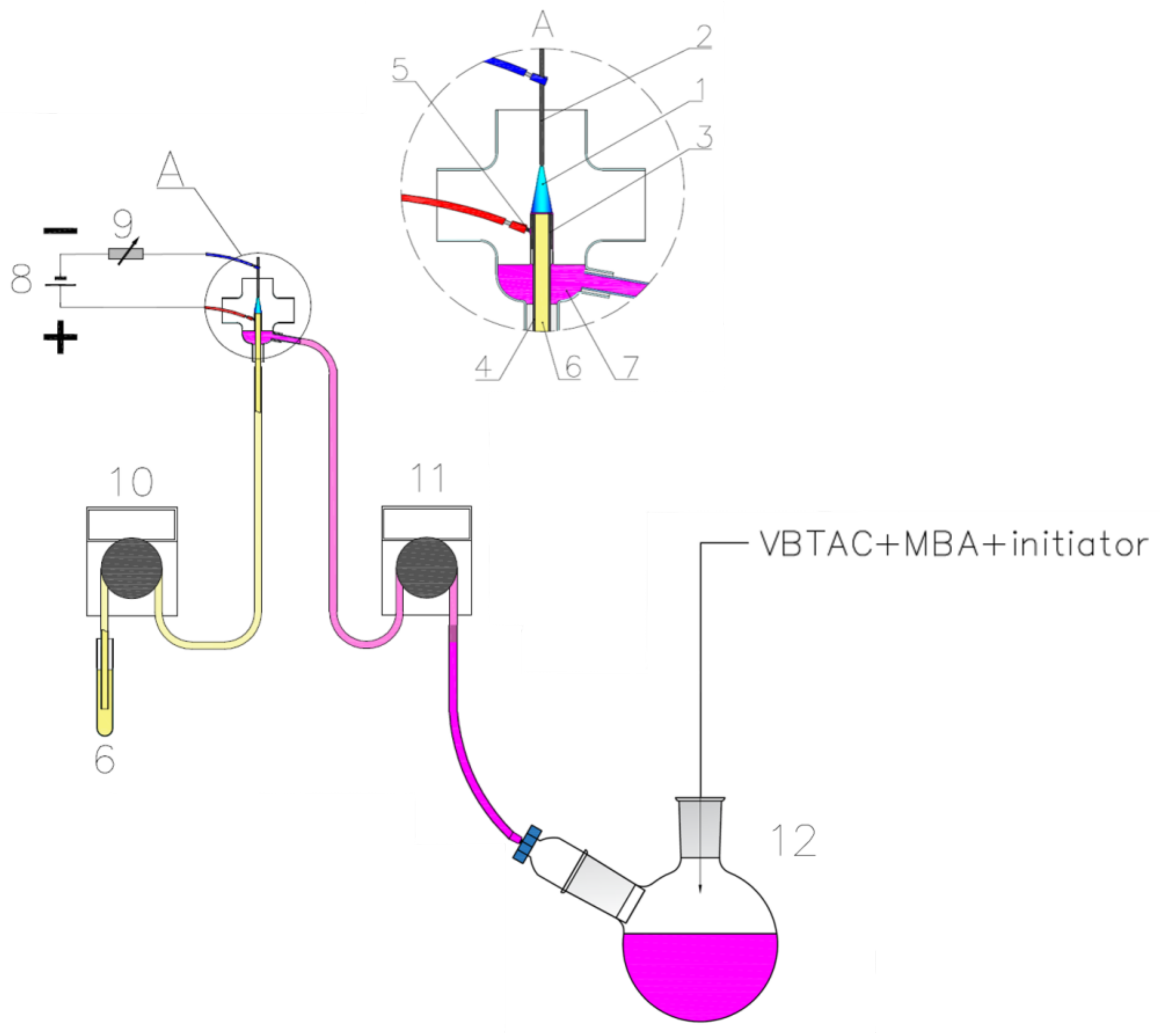


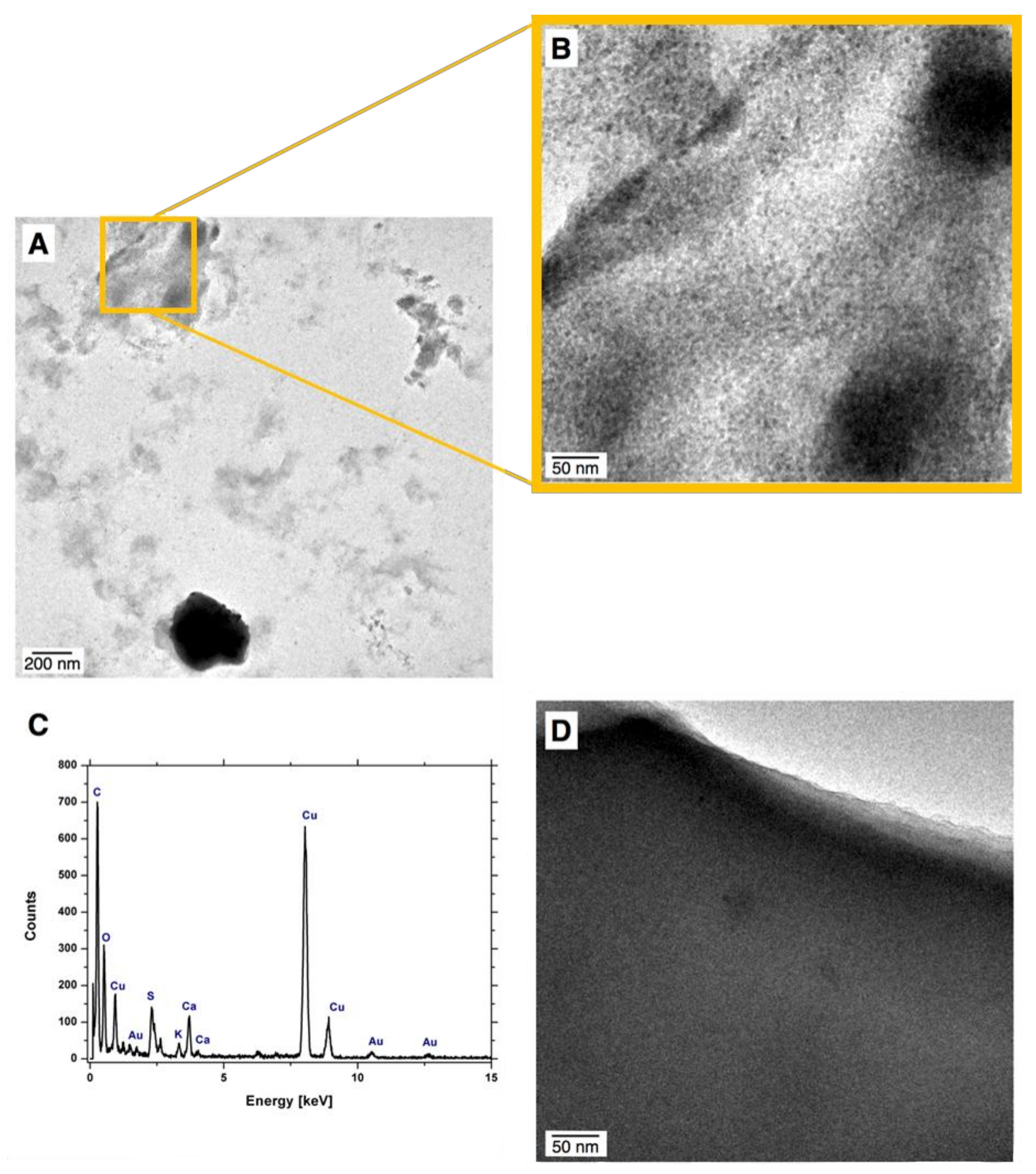
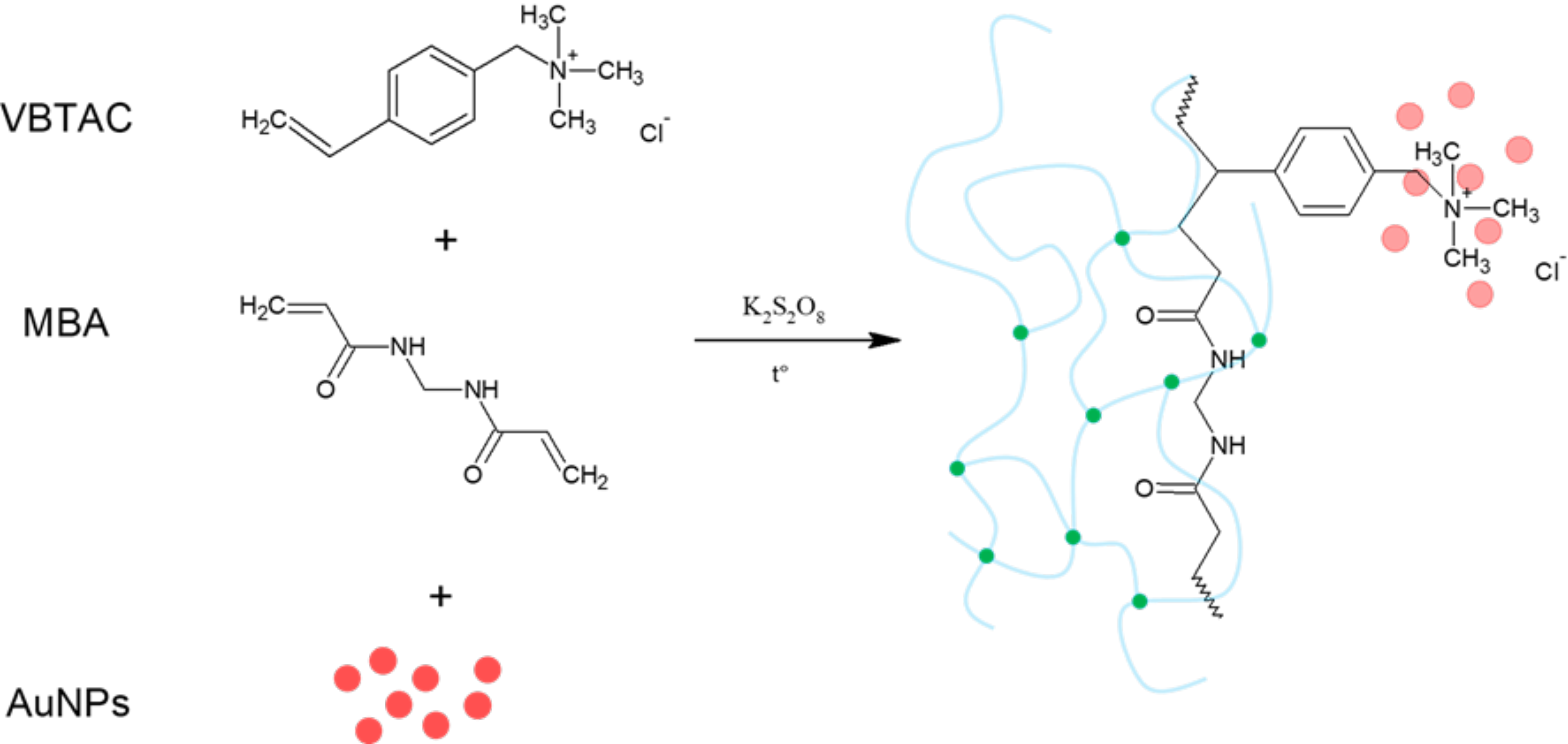
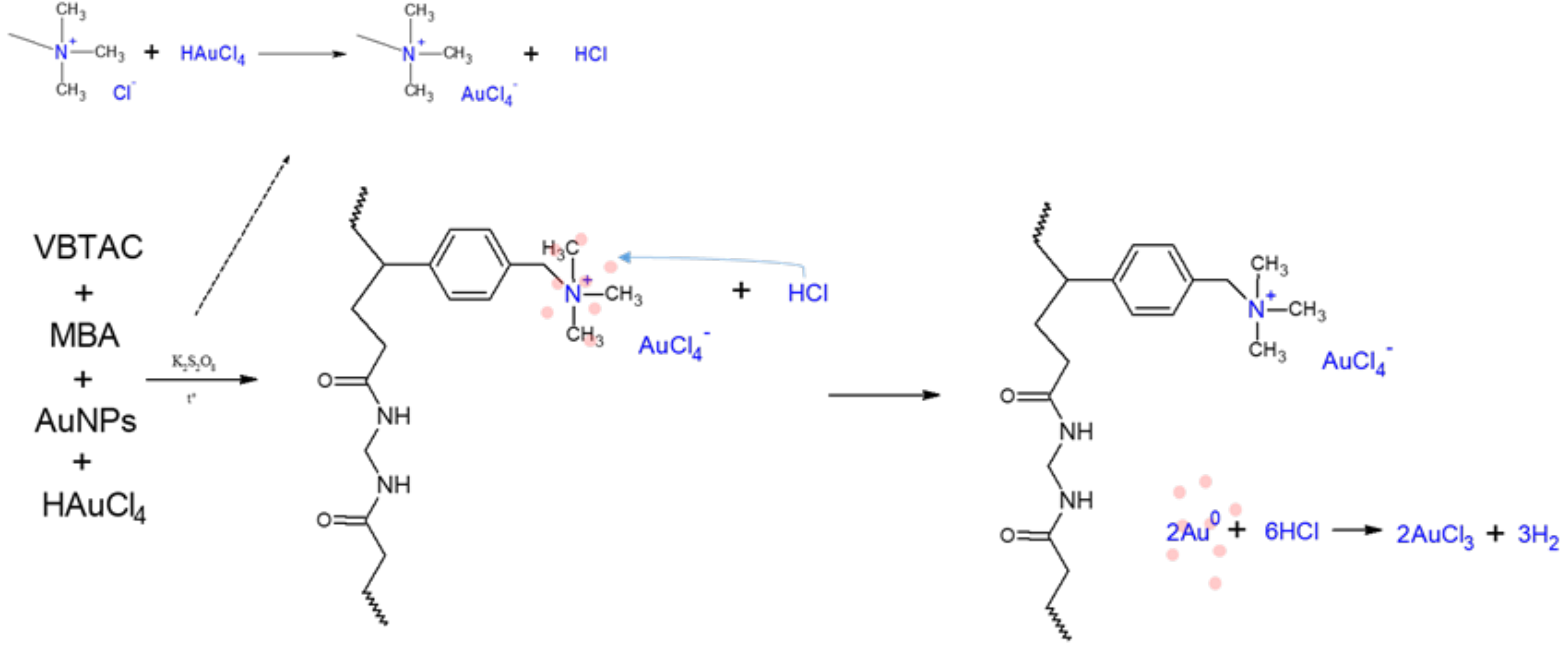
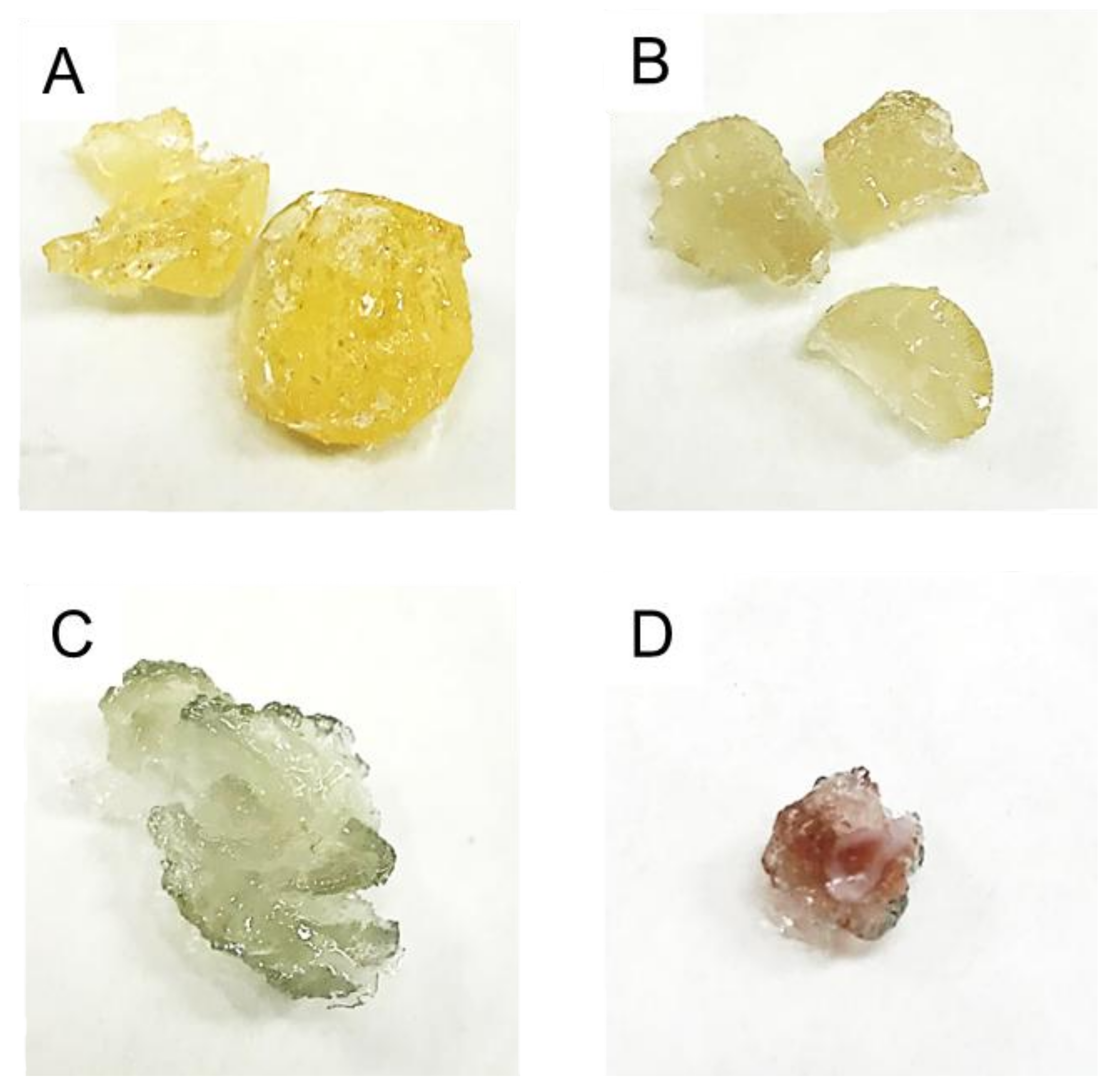
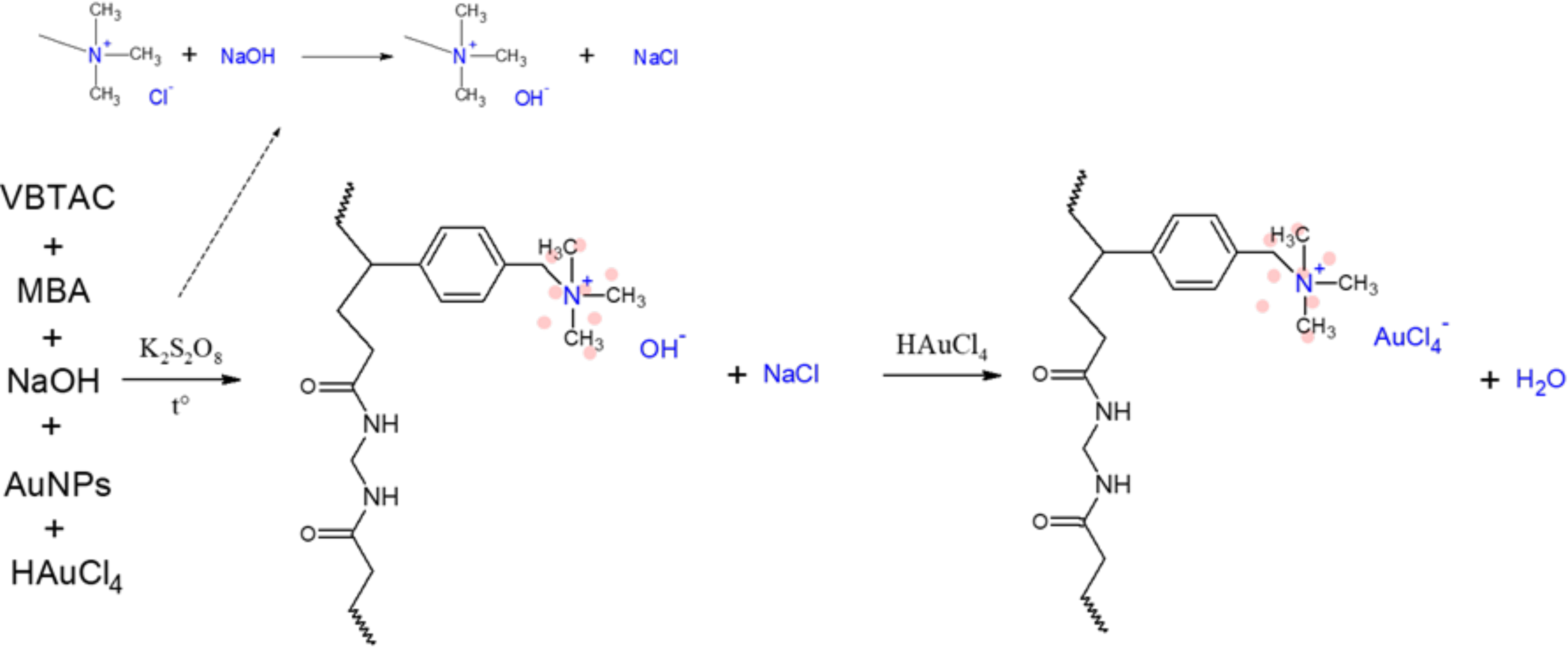

| Functionality | Wavenumber [cm−1] | ||
|---|---|---|---|
| VBTAC-co-MBA | Au/VBTAC-co-MBA | ||
| NC1 | NC3 | ||
| R-N+(CH3)3 | 1479 | 1479 | 1479 |
| N–H (amide deformation) | 1513 | 1513 | 1513 |
| C=O (amide stretching) | 1648 | 1651 | 1633 |
| AuCl4− | - | 580–345 # | |
| –OH (deformation) | - | - | 1334 1244 |
© 2018 by the authors. Licensee MDPI, Basel, Switzerland. This article is an open access article distributed under the terms and conditions of the Creative Commons Attribution (CC BY) license (http://creativecommons.org/licenses/by/4.0/).
Share and Cite
Cyganowski, P.; Dzimitrowicz, A.; Jamroz, P.; Jermakowicz-Bartkowiak, D.; Pohl, P. Polymerization-Driven Immobilization of dc-APGD Synthesized Gold Nanoparticles into a Quaternary Ammonium-Based Hydrogel Resulting in a Polymeric Nanocomposite with Heat-Transfer Applications. Polymers 2018, 10, 377. https://doi.org/10.3390/polym10040377
Cyganowski P, Dzimitrowicz A, Jamroz P, Jermakowicz-Bartkowiak D, Pohl P. Polymerization-Driven Immobilization of dc-APGD Synthesized Gold Nanoparticles into a Quaternary Ammonium-Based Hydrogel Resulting in a Polymeric Nanocomposite with Heat-Transfer Applications. Polymers. 2018; 10(4):377. https://doi.org/10.3390/polym10040377
Chicago/Turabian StyleCyganowski, Piotr, Anna Dzimitrowicz, Piotr Jamroz, Dorota Jermakowicz-Bartkowiak, and Pawel Pohl. 2018. "Polymerization-Driven Immobilization of dc-APGD Synthesized Gold Nanoparticles into a Quaternary Ammonium-Based Hydrogel Resulting in a Polymeric Nanocomposite with Heat-Transfer Applications" Polymers 10, no. 4: 377. https://doi.org/10.3390/polym10040377







